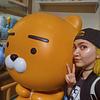Take a photo of a barcode or cover
The epilogue was beautiful - sad but beautiful - very glad it was included. Otherwise it might all have been a bit much.
In several ways felt more like a sequel to Ballad than a prequel to the originals. Not a bad thing though. Loved seeing more of
The character of Lenore Dove was great.
Felt very topical, timely, with the themes of propaganda and media+government driving the narrative through editorialising.
A lovely little authorial dig against generative AI! Quite on-the-nose but no complaints there tbh
I liked the incorporation of The Raven. Made it apparent early on how things would end with
Perhaps it wouldn't have hurt to quote a bit less of the poem in the book and leave it as a thing to explore afterwards. Though it did nicely underline
Definitely a good addition to the overall saga. Although the broad strokes were already known, plenty of surprises along the way, and a very poignant portrait of Haymitch.
If I had to criticise something, it did feel a bit out of character to have
Graphic: Addiction, Alcoholism, Animal death, Child death, Death, Drug abuse, Drug use, Gore, Gun violence, Mental illness, Physical abuse, Suicidal thoughts, Violence, Blood, Police brutality, Trafficking, Grief, Murder, Fire/Fire injury, Alcohol, Injury/Injury detail
Moderate: Torture, Kidnapping, Death of parent
Minor: Rape, Suicide, Terminal illness, War
haymitch is one of my favorite characters (along with johanna) so it was nice to get a fuller picture of his hunger games and his life/experience pre and post games. I really enjoyed his fellow district 12 allies and I really enjoyed ampert as well (ampert's death made me mad tho because one it was gruesome imagining it and two because I felt it was too quick/sudden). I enjoyed seeing more of beetee, mags, and wiress as well.
this was much much better than a ballad of songbirds and snakes but not as good as the main books in the series for me.
Graphic: Animal death, Body horror, Bullying, Child death, Confinement, Death, Drug use, Emotional abuse, Gore, Gun violence, Suicidal thoughts, Torture, Violence, Blood, Vomit, Police brutality, Medical content, Grief, Death of parent, Murder, Fire/Fire injury, Injury/Injury detail, Classism
Graphic: Bullying, Child abuse, Death, Gore, Physical abuse, Suicidal thoughts, Torture, Violence, Blood, Police brutality, Grief, Murder, Fire/Fire injury, War, Injury/Injury detail
Graphic: Alcoholism, Child death, Confinement, Death, Violence, Blood, Grief, Death of parent, Murder, Fire/Fire injury, Alcohol, Injury/Injury detail
Moderate: Vomit, Classism
Minor: Suicidal thoughts, Suicide, Torture, Police brutality, Medical content, War
It’s hard for me to judge this book neutrally because of my love of the original series, but I also think it would be a mistake to judge this book out of context. This is a book designed to add to and comment on the original series (and even elements of Songbirds & Snakes, so read that or watch the movie beforehand). Collins does bring in some familiar characters, but all in ways that actually serve the story and the world and don’t feel like cheap cameos or fan-service.
I would also argue that this book is very timely. This is not a spoiler, but spoiler warning anyway: Haymitch does not completely topple the totalitarian regime (otherwise, we wouldn’t need Katniss or her trilogy). But this book specifically explores small rebellions and their impacts, even when it feels futile. In a time when people feel powerless in the face of fascism, sometimes small rebellions are all we have. For a generation raised on stories of Chosen Ones and Exceptionally Gifted Teenager Heroes, it’s helpful to see that progress is frustratingly incremental, and the fruits of our labor often take time to blossom.
Not a perfect book, and definitely not a particularly happy one, but one that feels refreshingly relevant and gives young readers the respect and depth they deserve.
Graphic: Bullying, Child death, Death, Blood, Death of parent, Murder, Injury/Injury detail
Moderate: Animal cruelty, Animal death, Gore, Gun violence, Physical abuse, Suicidal thoughts, Police brutality, Fire/Fire injury, Classism
Minor: Addiction, Alcoholism, Cursing, Homophobia, Miscarriage, Torture, Vomit, Alcohol
Graphic: Child death, Death, Suicidal thoughts, Violence, Grief
Moderate: Miscarriage, Death of parent
Minor: Alcoholism, Suicide, Torture
Graphic: Child abuse, Child death, Death, Genocide, Violence, Blood, Death of parent, Murder
Moderate: Alcoholism, Torture, Grief
Graphic: Addiction, Alcoholism, Body horror, Bullying, Child abuse, Child death, Confinement, Death, Drug abuse, Drug use, Emotional abuse, Gore, Homophobia, Mental illness, Panic attacks/disorders, Physical abuse, Self harm, Suicidal thoughts, Torture, Violence, Forced institutionalization, Blood, Vomit, Police brutality, Medical content, Grief, Mass/school shootings, Medical trauma, Suicide attempt, Death of parent, Murder, Pregnancy, Fire/Fire injury, Alcohol, Injury/Injury detail, Classism
Graphic: Child death, Torture, Violence, Police brutality, Grief, Fire/Fire injury, War, Injury/Injury detail
Given Haymitch’s posture in the beginning of The Hunger Games, you know his backstory doesn’t end with a happy ending. But learning about how his character changed as a result of the games brought a new level of empathy to Haymitch and a deeper understanding of just what Katniss was up against in The Hunger Games trilogy. The story also tied up a few questions that the last prequel left its readers with. But most importantly, the story delivers timely messages that should not be ignored: Don’t take everything you see from the government at face value; don’t settle for a situation just because that’s the way it has always been; and don’t underestimate the power that one person can have - sometimes a spark is all that is needed.
This book did not disappoint, and the Easter eggs that transcend across each separate story are a delightful twist for the fans of this series.
Graphic: Child death, Violence, Murder, War
Moderate: Torture




